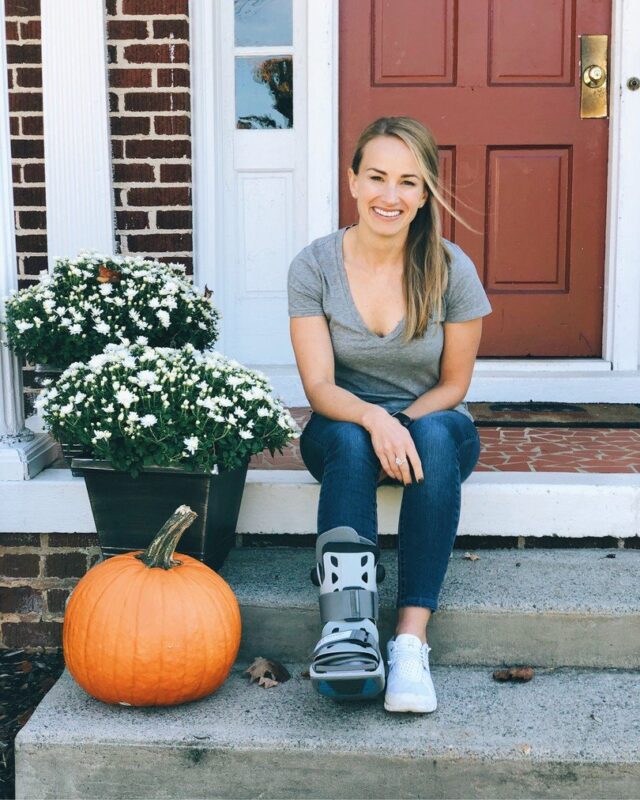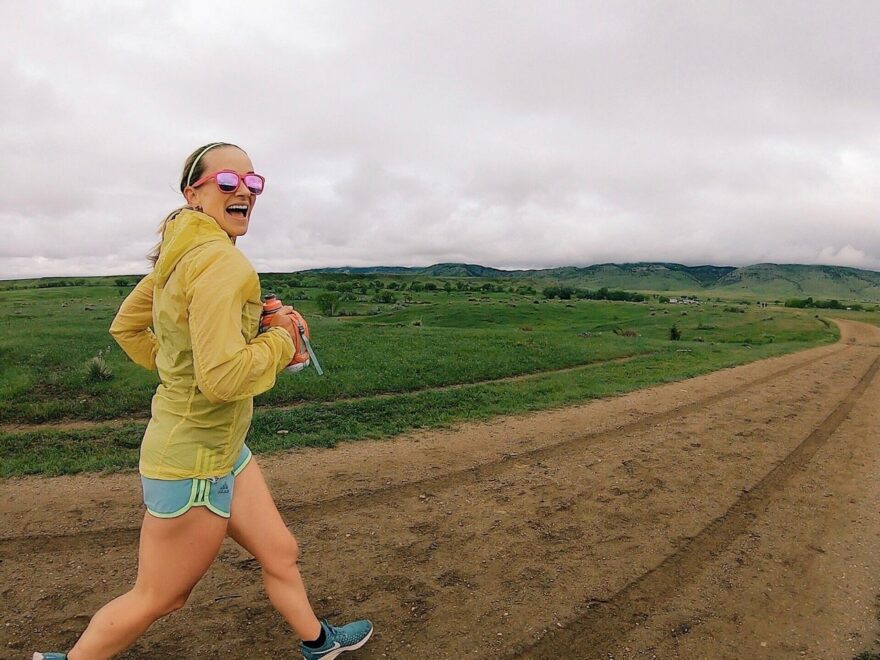


I got the scoop about plantar fasciitis, straight from a sports doc, including every treatment he throws at it and how long it really takes to heal. He also shared when you can run through it, and when you should see a doctor vs. just doing at-home treatments.
I dealt with plantar fasciitis for over a year, seeing massage therapists, a chiropractor, a physical therapist and buying homeopathic remedies (e.g. arnica gel), yet I never talked to an actual physician. Why? Because I was afraid he’d tell me to stop running. And I didn’t want to hear that. I LOVE RUNNING.

But, thanks to my partnership with Novant Health, I finally talked to a doctor about the best plantar fasciitis treatments and what the heck causes it. Dr. Zachary W. Sandbulte is a sports medicine physician at Novant Health Orthopedics and Sports Medicine in Winston-Salem.
He completed his undergraduate degree at the University of Washington and earned his medical degree at Virginia Commonwealth University School of Medicine. From there, he completed consecutive family medicine and sports medicine fellowships at the University of North Carolina at Chapel Hill.
During the course of his career, Dr. Sandbulte has practiced sports medicine at the high school, college and professional level. His notable experience includes work with several local high schools, the University of North Carolina basketball team, the Carolina Hurricanes, and the Special Olympics of North Carolina.

Outside of sports medicine, Dr. Sandbulte also has a heart for medical mission work. Early in his career,
he helped drill potable water wells for poor communities in Bolivia. Today, he is proud to continue to
support medical mission work around the world.
I had such a great conversation with Dr. Sandbulte – I hope you never deal with plantar pain, but if you do, this post has you covered.
It was reassuring to know that I really was doing just about everything I could on my own and that it just takes TIME. But, I do wish I’d gone to see a doctor since there were a few weeks when the pain was SEVERE and a professional definitely could have helped!
My questions are bolded and Dr. Sandbulte’s answers are below each question!
The fascia is a connective tissue under the foot and when it’s under chronic stress (which can come from a number of things), it will thicken, get inflamed and become degenerative.
It typically presents as pain at the origin of the fascia, which is near the heel bone.
Plantar fasciitis can come from many things, which is what makes it so hard to say exactly what caused it. And it’s rarely just one thing, but rather 5-6 things that cause it. Contributing factors include:
You’ll have pain in your arch and heel, particularly when you first get out of bed. When people come see me for plantar pain, I also think through, What’s the worst case scenario – let’s prove it’s NOT that.
People think they may have plantar fasciitis but it could be something that requires a different treatment or something more serious.
If you don’t have any of those, but exhibit pain when you walk under you heel, it’s likely plantar fasciitis.
There are lots of stretching exercises you can do at home. Google them. Do them! (A physical therapist or a doctor can also prescribe some if you do get a professional’s help.)
Stretch your foot in bed before you even step out of bed in the morning. It will help with the initial pain. Same thing applies if you sit at a desk all day.
Use a golf ball to massage the bottom of the foot. A frozen water bottle will also help massage and address some inflammation.
These can help if there is any inflammation, but it depends the case. It may not help, so don’t rely only on that.
I throw everything at it that I’ve got to see what works since there’s not one silver bullet. And the first thing I do, is to make sure they’re doing all the home treatments. Then, we look at additional treatments.
This brace has air bladders that help massage Achilles tendon & fascia at the same time.
We do a steroid injection next to the fascia layer to help with swelling/inflammation. Studies show that when it’s done with ultrasound guidance that it can be helpful.
I get asked a lot how much it will hurt, and to be honest, the shot is pretty uncomfortable compared to other shots. But, I tell my patients if the pain is bad enough that a shot in your foot sounds doable, let’s do it.
This is a newer technology for plantar fasciitis treatment and limited studies show it can be helpful. We spin the patient’s blood, take out the platelet layer from the heel layer and inject a concentrated dose into the fascia layer to stimulate healing.
It’s super rare that we go this route. I’ve seen hundreds, if not thousands, of plantar cases and I can think of only a few cases where they ultimately had surgery.
Try treating it at home first and DO ALL THE THINGS to treat it! But, if your pain gets to a 7 or 8 on a scale of 10 or you can’t work out with it, go see a doctor.
It’s usually a long-term process, anywhere from 4 months to 2 years.. There’s no quick or simple solution. So, I try to set expectations with patients. There’s no a fast way to heal it and there’s certainly no overnight cure. It takes time to get the tissue healed. Most people don’t like hearing that!
You can still run but let pain be your guide. If you run, it will make it more sore. So if you’re okay with that, I’m okay with it. Running won’t make it a lot worse, as long as you’re doing the stretches!
But, I will say, runners have a high pain tolerance so they power through pain more than they should. I suggest you decrease mileage for a while to see if it helps. I’ll cut your mileage back to 25% of your pre-injury mileage. With each successful week, you can increase 10-15%.
The “best shoe” really depends on the person and their foot shape. But everyone needs good cushion and good support to pad the foot strike. And when you’re not running, don’t walk around barefoot and don’t wear flip flops.
They might.
If your pain is a 4 out of 10, start with over-the-counter inserts. They’re cheaper and easier to get than custom orthotics. But, if your pain is severe, we typically just start with custom ones.
For OTC inserts, I typically have people go to Fleet Feet where they’ll measure your feet and recommend the right ones for your foot shape.
I’m okay if people try other treatments at physical therapy, but it’s really the stretching that helps more than anything. The achilles tendon in particular needs to be stretched. People stretch the gastrocnemius but they skip the soleus.
Some of the extra things at PT may help but there isn’t enough data to show conclusively that it really helps.
The bottom line about plantar fasciitis is that it’s a soft tissue problem… and once the tissue undergoes an architectural change, it takes a LONG time for it to go back.
It’s particularly frustrating because every time you step on it – which is all day, every day — you remember and think of it! But, consistent work with the at-home treatment really will go a long way, even when it seems it’s not helping. So stick with it and be patient!
Thank you so much for your time, insight and expertise Dr. Sandbulte! And don’t you worry, we runners are really good at being patient with injuries. Right?
This post was sponsored by Novant Health. A big thank you to them for not only supporting my blog, but also supporting me and my readers in reaching our running goals and living long, healthy lives!
You may also like:


Leave a Comment
4 responses to “What actually works when treating plantar fasciitis”
A knowledgeable and skilled massage therapist can do wonders as it is a soft tissue issue. It’s all in the calf. 🙂 Thanks for the informative post!
AMEN!!! My massage therapist is a huge part of how I keep running injuries at bay!
This is great! I had it in my left foot and it got better, and now I have it in my right foot. I will try to be better about doing the stretches. I also am AWFUL at wearing proper shoes (I know I need new walking shoes and I know I need to get better sandals that cushion my foot. But it’s hard!)
I found it made a huge difference when I only wore legit sneakers as much as possible (they were actually Nike Pegasus running shoes that were NOT worn out). I still wear them when it starts to flare and ditch sandals! KorkEase makes the cutest sandals I’ve found that don’t torture my plantar! I have these and LOVE them: https://rstyle.me/+J1RwVi-y9QUnry4uwKvi1g